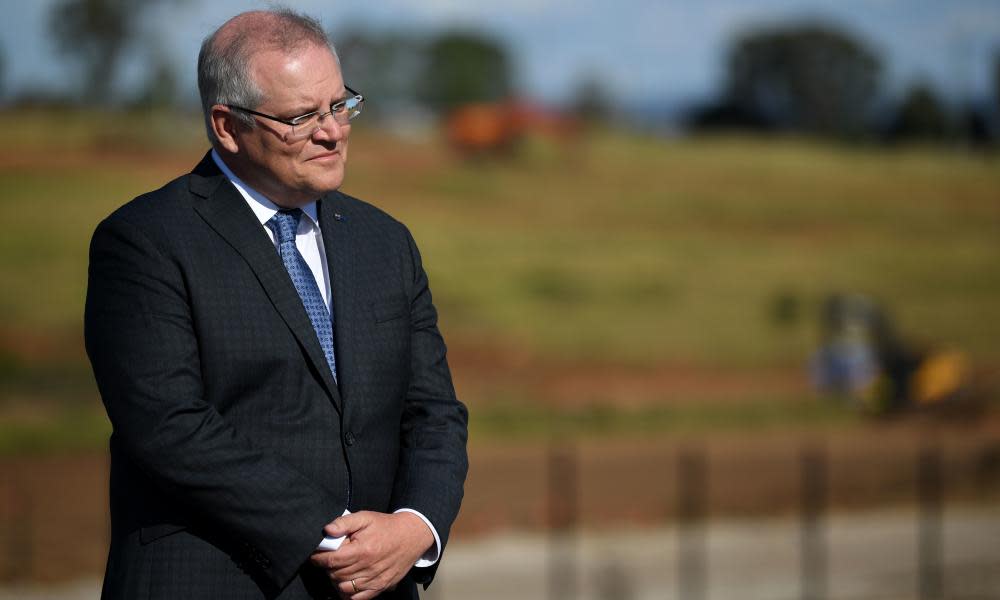Scott Morrison should use Cook's 250th anniversary to insist Britain re the Gweagal shield

Depending on where you stand, an upside of Australia’s coronavirus lockdown has been the abandonment of some of the more public and political elements of national celebrations to commemorate the 250th anniversary of James Cook’s arrival.
The slated Australian circumnavigation by the replica Endeavour was abandoned (Cook himself never did circle the continent anyway) while the big day itself – 29 April 2020 – passed with little more than official murmur.
Instructively, however, the plan for a $50m revamp of the site at Kurnell in Kamay national park where Cook first stepped on the east coast (and promptly shot at least one Gweagal tribesman before stealing spears and a shield) appears to be proceeding.
Kurnell is a monolith of the national psyche, looming as either (again depending on your view) the place that opened the door to post-Cook invasion and all the ills of colonisation – or the vanguard of continental civilisation and modernity.
The prime minister, Scott Morrison – the member for Cook (named after the navigator) and a big booster of the Yorkshire lieutenant, unambiguously said: “As the 250th anniversary nears we want to help Australians better understand Captain Cook’s historic voyage and its legacy for exploration, science and reconciliation. That voyage is the reason Australia is what it is today and it’s important we take the opportunity to reflect on it.”
It’s a position supported by most in government and opposition; challenging the Cook national foundation myth remains as dangerous in public life as accepting the absurd proposition that the modern Australian federation (and all of the Indigenous misery and racism at its fundaments) was forged on the shores of Gallipoli in 1915.
While Kurnell – on the southern shore of what became Botany Bay – might be notorious in the Australian imagination, few actually go there. Not many Sydney residents let alone interstate visitors, who gravitate to the glittering harbour and its totems to modernity, would know where Kurnell is, never mind visit.
The visitor’s centre is an uninviting shrine to Cook, its attempt to dissect the clash of civilisations that began a stone’s throw away on the foreshore imbued with the clumsy museological ethnology of the 1980s. School kids and others do visit. But on three consecutive visits to it and the surrounding memorial site last year, I barely saw another soul.
Despite an intent to incorporate greater Indigenous agency and perspective into any new Kurnell visitor centre and memorial site (currently characterised by the view through an acute, outdated Anglo-Australian lens) will the visitors come? What could make it worthwhile or truly special?
The return of that Gweagal shield, held tightly by the British Museum (among 6,000 Australian Indigenous cultural items, stolen and otherwise acquired) to its precise place of origin – its country – has the power to distinguish the visitor centre.
Before the global Covid-19 pandemic, tentative overtures had been made from high levels of the federal government to Britain urging the return of the shield for Cook’s 250th. In recent years the New South Wales lower house passed a motion calling for the shield’s return. Last December federal parliament debated a similar motion moved by Labor’s Matt Thistlethwaite and Linda Burney. Several government MPs spoke in favour of Britain returning the shield.
Rodney Kelly, a sixth-generation descendant of the warrior Cooman, who Cook shot on that day of first contact in 1770, has long been lobbying the musuem for the return of his ancestral shield.
He last met senior officials from the museum in December. But again there was little significant progress, he says.
“How ever that shield comes back here – whoever gets it back – it doesn’t matter to us. But it belongs back here and the right place to keep it would be at Kamay,” Kelly says.
“It’s at the point now where [Morrison] could make a real difference in getting it back here for good if he wanted to.”
The shield was returned to Australia briefly in 2015 for an exhibition, Encounters, at the National Museum of Australia. It was protected (at the request of the British government and the museum) by a special Australian act of parliament, the Protection of Cultural Objects on Loan Act to avoid any repeat of 2004 when Indigenous activists seized three barks belonging to the Dja Dja Wurrung people of Victoria, while they were on loan from the British Museum to the Melbourne Museum. After a protracted court case the barks returned to London.
The British Museum has been intransigent in its refusal to countenance a return of the shield to Australia – even under the guise of a so-called “permanent loan” to a major gallery or museum in Sydney.
Returning it to Kamay, to a purpose-built institution on the site from which it was stolen, in the heart of the Australian prime minister’s electorate, might sound like a more persuasive proposition to the museum … especially if the British government is lobbied at a similarly senior level.
It would be premature to overstate the conciliatory value of this repatriation at a time when the federal government continues to stifle so many Indigenous rights, outcomes, hopes and opportunities. Still, its return would transcend the realms of gesture.
The shield is a portal to – and a portent of – the experience of: an unceded Indigenous sovereignty stretching back further and further the more we look; British arrival, land-grab and illegal possession; violent dispossession, and ongoing oppression. It encapsulates Indigenous survival, adaptability, continued resistance and endurance.
It should be brought back in Kamay. The member for Cook ought to insist Britain give it back now if he wants the Cook commemorations to amount to anything much worthwhile. After 250 years of wrongs, that’s only right.

 Yahoo News
Yahoo News 
